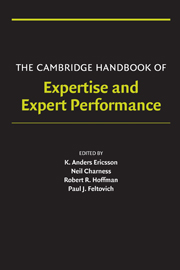Book contents
- Frontmatter
- Contents
- Acknowledgments
- Contributors
- PART I INTRODUCTION AND PERSPECTIVE
- PART II OVERVIEW OF APPROACHES TO THE STUDY OF EXPERTISE – BRIEF HISTORICAL ACCOUNTS OF THEORIES AND METHODS
- PART III METHODS FOR STUDYING THE STRUCTURE OF EXPERTISE
- 8 Observation of Work Practices in Natural Settings
- 9 Methods for Studying the Structure of Expertise: Psychometric Approaches
- 10 Laboratory Methods for Assessing Experts' and Novices' Knowledge
- 11 Task Analysis
- 12 Eliciting and Representing the Knowledge of Experts
- 13 Protocol Analysis and Expert Thought: Concurrent Verbalizations of Thinking during Experts' Performance on Representative Tasks
- 14 Simulation for Performance and Training
- PART IV METHODS FOR STUDYING THE ACQUISITION AND MAINTENANCE OF EXPERTISE
- PART V DOMAINS OF EXPERTISE
- PART VI GENERALIZABLE MECHANISMS MEDIATING EXPERTISE AND GENERAL ISSUES
- Author Index
- Subject Index
- References
9 - Methods for Studying the Structure of Expertise: Psychometric Approaches
from PART III - METHODS FOR STUDYING THE STRUCTURE OF EXPERTISE
- Frontmatter
- Contents
- Acknowledgments
- Contributors
- PART I INTRODUCTION AND PERSPECTIVE
- PART II OVERVIEW OF APPROACHES TO THE STUDY OF EXPERTISE – BRIEF HISTORICAL ACCOUNTS OF THEORIES AND METHODS
- PART III METHODS FOR STUDYING THE STRUCTURE OF EXPERTISE
- 8 Observation of Work Practices in Natural Settings
- 9 Methods for Studying the Structure of Expertise: Psychometric Approaches
- 10 Laboratory Methods for Assessing Experts' and Novices' Knowledge
- 11 Task Analysis
- 12 Eliciting and Representing the Knowledge of Experts
- 13 Protocol Analysis and Expert Thought: Concurrent Verbalizations of Thinking during Experts' Performance on Representative Tasks
- 14 Simulation for Performance and Training
- PART IV METHODS FOR STUDYING THE ACQUISITION AND MAINTENANCE OF EXPERTISE
- PART V DOMAINS OF EXPERTISE
- PART VI GENERALIZABLE MECHANISMS MEDIATING EXPERTISE AND GENERAL ISSUES
- Author Index
- Subject Index
- References
Summary
“Psychometrics” refers to the scientific discipline that combines psychological inquiry with quantitative measurement. Though psychometric theory and practice pertain to all aspects of measurement, in the current context, psychometric approaches to expertise pertain to the measurement and prediction of individual differences and group differences (e.g., by gender, age) and, in particular, high levels of proficiency including expertise and expert performance. The scientific study of expertise involves several important psychometric considerations, such as reliability and validity of measurements, both at the level of predictors (e.g., in terms of developing aptitude measures that can predict which individuals will develop expert levels of performance), and at the level of criteria (the performance measures themselves). We will discuss these basic aspects of psychometric theory first, and then we will provide an illustration of psychometric studies that focus on the prediction of expert performance in the context of tasks that involve the development and expression of perceptual-motor skills, and tasks that involve predominantly cognitive/intellectual expertise. Finally, we will discuss challenges for future investigations.
Before we start, some psychological terms need to be defined. The first terms are “traits” and “states.” Traits refer to relatively broad and stable dispositions. Traits can be physical (e.g., visual acuity, strength) or psychological (e.g., personality, interests, intelligence). In contrast to traits, states represent temporary characteristics (e.g., sleepy, alert, angry). The second set of terms to be defined are “interindividual differences” and “intraindividual differences.”
Information
- Type
- Chapter
- Information
- The Cambridge Handbook of Expertise and Expert Performance , pp. 147 - 166Publisher: Cambridge University PressPrint publication year: 2006
References
Accessibility standard: Unknown
Why this information is here
This section outlines the accessibility features of this content - including support for screen readers, full keyboard navigation and high-contrast display options. This may not be relevant for you.Accessibility Information
- 13
- Cited by
